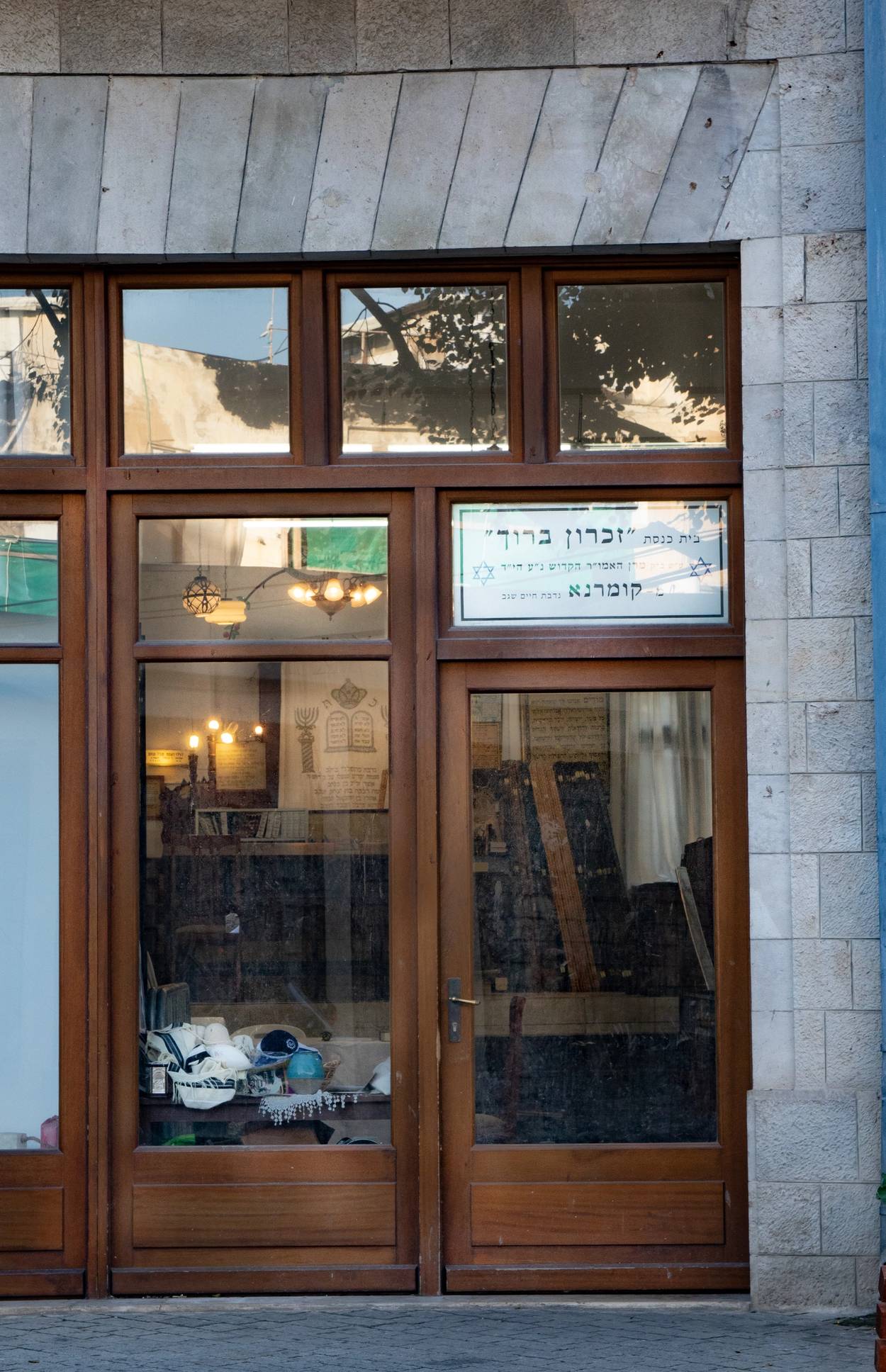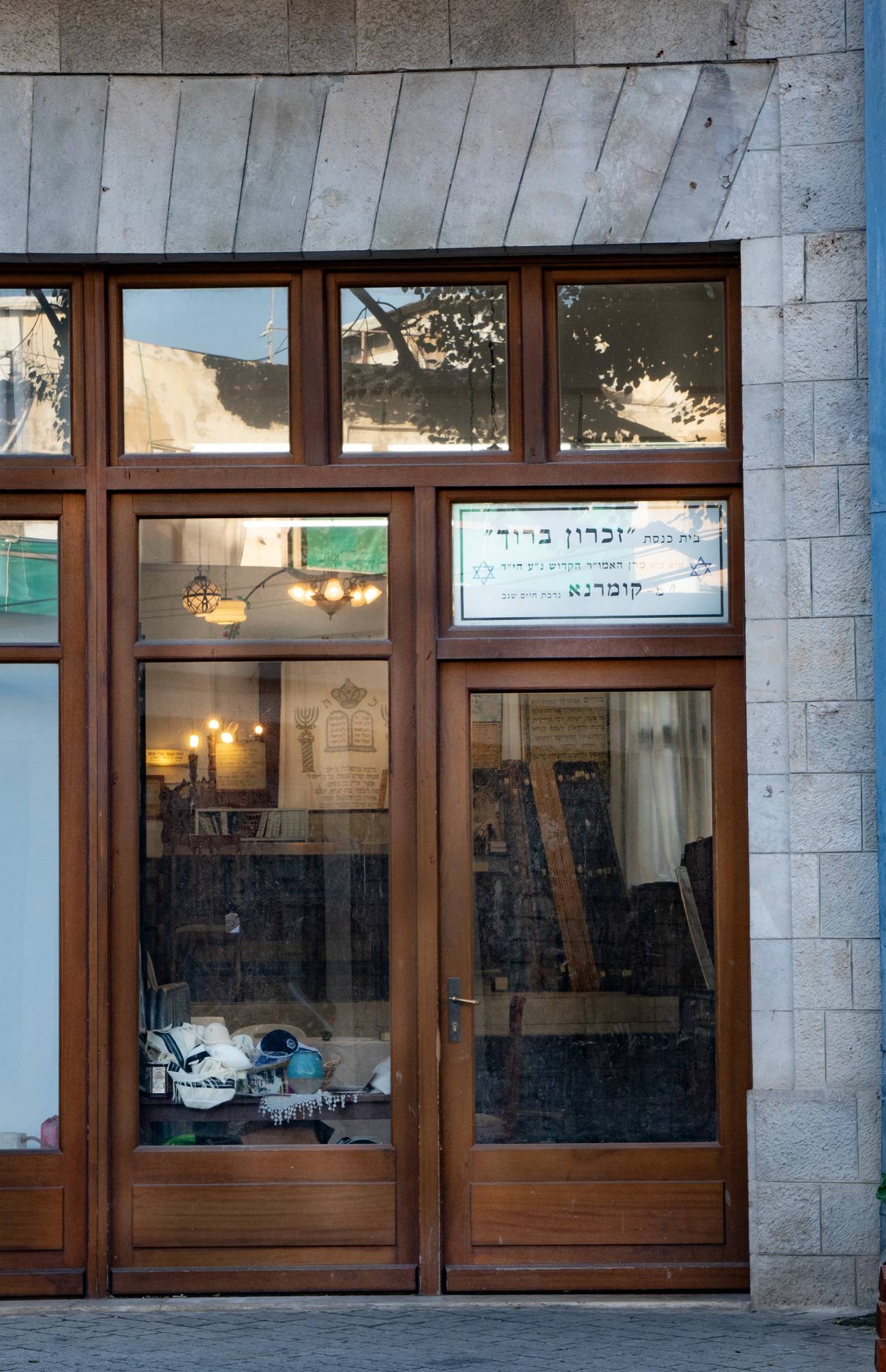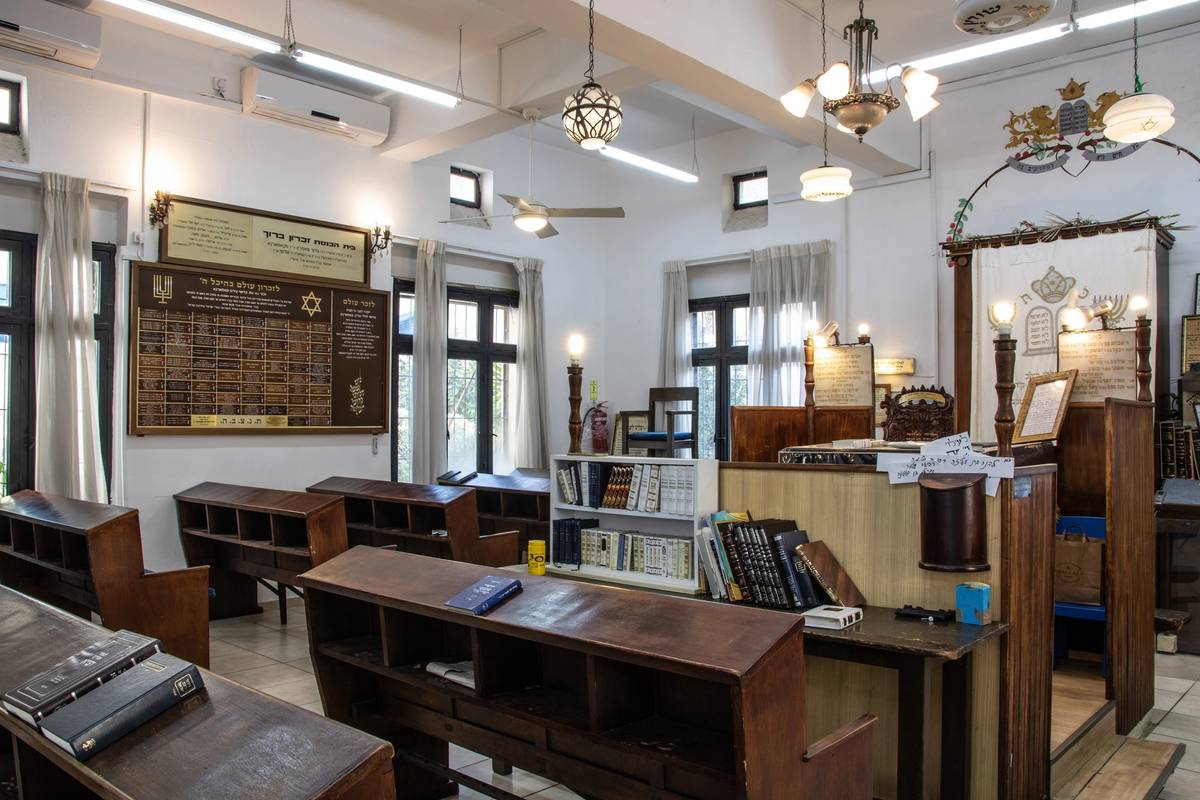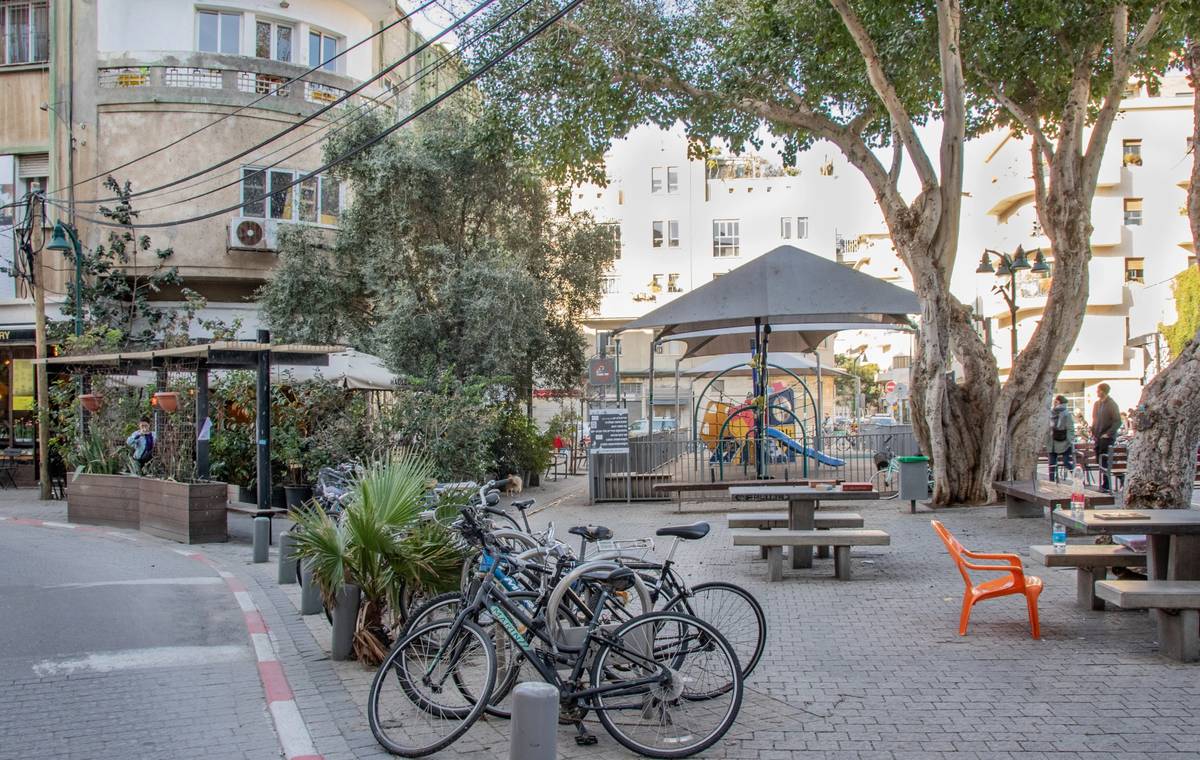Jaffa’s Revolutionary Synagogue
A new congregation in an old space, Zichron Baruch blends Ashkenazi and Sephardic traditions, drawing a mix of Orthodox and non-Orthodox, Israelis and immigrants




It’s late Saturday morning in a compact urban park in Jaffa, in the neighborhood known as Noga. The azure sky and the warm midday sun make this winter day feel almost like summer. Children swarm on the slides and swings, while their parents stand around drinking coffee from paper cups and Thermos mugs. Other people, young and old, sit at tables outside the Urban Bakery café sipping lattes and savoring croissants.
In another corner of the park, several dozen people, mostly 20- or 30-somethings, stand around folding tables laden with flaky bourekas, a traditional Sephardic pastry, Yemenite jachnun, herring, kugel, and chamin—the Sephardic cholent. They are drinking single-malt whiskey, arak, and wine from flimsy disposable plastic cups, while toddlers roam at their feet. One boy, with side curls down to his shoulders, darts in and out on Rollerblades. The men—some dressed in jeans or Bermuda shorts and T-shirts, others in khaki slacks with white shirts—wear kippot on their heads. Some have the strings of their tzitzit hanging out from under their shirts. There is one in the crowd wearing a black kapota (coat) and a large black fedora. Another, in khaki slacks, a white linen shirt, and sandals, has side curls tucked behind his ears. The women—some in slacks or cute short dresses, others in ankle-length skirts and artfully wrapped, brightly colored headscarves—chat animatedly with the men and with one another while everyone tries to keep half an eye on the kids. A few of the men and women sport tattoos on their arms or ankles. Snippets of conversation can be heard in Hebrew, English, French, and Turkish. The proprietor of the adjacent pottery shop and some of his customers are invited to join in a l’chaim. As they raise their cups to their lips, the air echoes with the muezzin’s call to prayer from the nearby mosque.
This is the weekly kiddush after Shabbat morning services at Beit Knesset Zichron Baruch, a small synagogue off the beaten track, where a revolution is subtly happening in Tel Aviv.
The synagogue faces the park. From the outside, it is a simple storefront in a block of tastefully renovated apartment buildings with galleries and trendy shops on the street level. Inside, it opens into a well-lit room that looks like an old-time shul, with worn, dark wooden pews. A row of folding rattan screens down the center of the room forms the mechitza separating the men’s from the women’s side of the hall. A plaque in memory of the Jews of the Ukrainian village of Kamarna—most of whom were murdered by the Nazis in two aktions, in 1942 and 1943—dominates one wall. The synagogue was established in the mid-1950s by survivors from that village who had immigrated to Israel. They named it Zichron Baruch after the Hasidic Rebbe of Kamarna, Rabbi Baruch Safrin, who was among those murdered.
Over the years, the neighborhood declined; the population changed. By the early 1990s the synagogue was all but abandoned. However, in the late ’90s workers and shopkeepers in the neighborhood wanted a convenient place for mincha (afternoon prayers) during the workday. They cleaned up the empty synagogue to use for those prayers, breathing new life into the place.
In the absence of congregants who lived nearby, the synagogue remained closed on Shabbat and on holidays. It was during this period that Adam Baruch, an Israeli journalist, editor and art critic, joined the congregation. He wrote about the Hasidim of Kamarna and feeling the presence of the rebbes of the now defunct Kamarna Hasidic dynasty in the synagogue when he prayed. It was as if he could see their scholarly and philosophical works written on its walls.
The synagogue continued as a weekday house of worship for the next decade. In the early 2000s, young Jews began moving into Jaffa, attracted by lower rents than in central Tel Aviv, the artists’ studios, cafes, and an increasingly hip vibe. One of them was a lawyer-cum-surfer named Shelly Malka, a secular Jew who was an unlikely revolutionary.
Malka, the son of a Moroccan father and a Yemenite mother, grew up in a Masorti (traditional) Jewish home in Hadera, in central Israel. Although both his maternal and paternal grandfathers were religiously observant, Shabbat was not strictly observed in Malka’s childhood home.
When he moved to Tel Aviv, Malka returned to his religious roots. On his way to Shabbat services in the adjacent neighborhood of Neve Tzedek, he passed the locked doors of Zichron Baruch and resolved to revive the place as a house of worship on Shabbat and holidays. Unfortunately, there still was no religious community in the neighborhood.
As Malka was thinking about reopening the synagogue, he ran into Lotan Sher, an acquaintance who had just moved to Jaffa with his wife, Efrat Buzaglo. Sher had grown up in a religious Ashkenazi home in the largely secular community of Kohav Yair, in central Israel. He, too, is another improbable leader of a revolution. At 37, Sher, an engineer by training, works for a commercial real estate firm. He and Malka committed to work together to fully reopen the synagogue.
The synagogue opened its doors as a full-time congregation in 2013, with services Friday evening and Saturday morning, in addition to the weekday mincha prayers. It was rededicated as Zichron Baruch, the same name it had originally, but this time also in memory of Adam Baruch, who had died in 2008. A small plaque in his memory now hangs on the wall opposite the memorial to the Jews murdered in Kamarna.
“In the early days after the synagogue reopened, I recruited my surfer friends to come to make the minyan,” Malka recalled. He or Sher would often stand out in the park opposite the synagogue trying to persuade passersby to come in to be the 10th man. That era was short lived. Very quickly, word got around, and people began coming from surrounding neighborhoods: Florentin, Neve Tzedek, south Yafo, and beyond. “The spirit of the services spoke to people. They felt at home,” observed Malka. Now, the synagogue is filled to overflowing every Friday night and Saturday morning.

Buzaglo, a bubbly woman who looks younger than her 40 years, grew up in a Shabbat-observant Moroccan family in Netivot, in the south of Israel. “I’ve never had any doubt that the synagogue, and the Torah—they are the truth,” she asserted. Buzaglo refers to the shul as “our baby.” She and Sher used to wash the floors of the synagogue every Friday and make all the arrangements for the weekly kiddush. “Where food is served, Jews will come,” she observed with a smile.
Unlike most synagogues that follow either the Ashkenazi or the Sephardic tradition in the liturgy, Malka and Sher created a hybrid service that draws from both customs. For the most part, the text is the same. The differences come in the sequence of some of the prayers, the tunes, and which passages are sung or said aloud. The combination they came up with seems to have struck a chord. After reading the Song of Songs aloud, in the Sephardic tradition, the Friday evening Kabbalat Shabbat service is one of joyous song, in the Carlebach style. Shabbat morning services may begin with Moroccan melodies and end with Hasidic nigunim, all sung with moving energy and authenticity.
As the congregation has grown, Malka and Sher have enlisted a few of the congregants to assist them as gabbais, who help organize and lead the services and other activities of the shul. This group includes, in addition to Malka and Sher and a couple of other “mainstream” Ashkenazim and Sephardim, a Bratslav Hasid and a Chabad rabbi. Each adds his own flavor to the services, without insisting that one tradition or another dominate.
During the height of the pandemic, when group prayer was only permitted outdoors, the leaders of the congregation got permission to use a courtyard of a commercial building near the synagogue for services. The singing and clapping during the services, particularly on Friday nights, caught the attention of neighbors passing in the street. Some were moved to stop and see what was going on. A number joined the services and have attended ever since, to the point that Friday night services are now routinely held outdoors. The synagogue building is simply not big enough to contain everyone.
When the synagogue reopened in 2013, most of the worshipers were singles or newly married couples. Now, the place teems with youngsters. It’s not uncommon for men to arrive Shabbat morning with a baby in a pouch strapped to their chests. And the men leading the prayers often have toddlers in their arms. Several of the young married couples at the shul met there. Many of them have moved to the neighborhood, attracted in part by its proximity to the synagogue.
The congregation includes native Israelis and recent immigrants, particularly Anglos and French. It’s a living example of kibbutz galuot (the ingathering of the exiles). The Rabbanut sends candidates for conversion to Zichron Baruch, where they are warmly received. The converts have included people from France, Germany, Sweden, Ukraine, and even a local Arab. The shul is currently sponsoring four people who are in the process of converting to Judaism.
The success of Zichron Baruch bespeaks a quest on the part of young Israelis to connect to their Jewish roots, but to do so on their own terms. They want a community that will respect them for who they are, regardless of their sexual orientation, or whether they are fully observant or simply seeking an embracing environment. The shul fills that need. Ariel Goldberg, 31, who moved to Israel from the United States 10 years ago, is the son of a Persian Muslim mother and an American Jewish father. He recently completed his conversion. “To me, being part of Zichron Baruch means being part of a community of real humans with different backgrounds and beliefs, who have chosen to connect to Judaism to become better humans, to be more accepting and less judgmental,” he explained.
High-tech entrepreneurs, poets and musicians pray with chefs, mechanics, carpenters, and massage therapists. In addition, the division between Ashkenazim and Sephardim is becoming increasingly blurred in Israeli society as more families have mixed Ashkenazi and Sephardi roots. Yet most synagogues throughout the country continue to follow one tradition or the other. The Great Synagogue on Allenby Street in Tel Aviv is Ashkenazi, and the Sephardi Great Synagogue is on Shadal Street. Small neighborhood shuls are likewise either Ashkenazi or Sephardic. The unusual mélange of both traditions that characterizes the services at Zichron Baruch speaks to this new Israeli norm.
The shul is also a manifestation of another recent Israeli phenomenon. At a time when Jewish religious observance in the United States is imploding, the opposite is true in Israel. Since the beginning of the 21st century, the percentage of Israeli Jews who observe religious tradition has increased from 19% to 26%. Correspondingly, a smaller percentage of Jews define themselves as secular. Zichron Baruch, as an Orthodox synagogue that is open and receptive to all, provides an ideal landing place for formerly secular Israelis seeking a foothold in traditional Judaism.
Not everyone was enthusiastic about the reopening of Zichron Baruch. A group of owners of the condominiums in the building where the synagogue occupies some of the ground floor, objected strenuously. Claiming that the noise disturbed them, they sued the synagogue and the Tel Aviv municipality for permitting the synagogue. Such a lawsuit against a synagogue in Europe or the United States would immediately raise cries of antisemitism. Here, it’s Jews against Jews. As the judge said to the plaintiffs, “You would not have dared to sue the local mosque” whose muezzin’s call blares over a loudspeaker five times a day.
Although it appears the Zichron Baruch will prevail in the long run, the ongoing lawsuit has put substantial financial strain on the young congregation, which charges no dues and has no major financial backers. It is funded solely by contributions from the congregants. Ironically, the legal action, according to Malka, has galvanized congregants and strengthened the synagogue.

“Prayer is the anchor,” Malka explained. At no time is this more apparent than on Yom Kippur. The culmination of the holiday is the Ne’ila service at the end of the day of fasting and prayer. Zichron Baruch attracted so many people for the holiday that two services were held simultaneously, one indoors and the other outdoors. Hundreds of people packed into the courtyard for the concluding prayers, which were led by Akiva Turgeman.
Akiva, as he is known professionally, is a phenomenon. The son of a Yemenite rabbi, Akiva grew up in Dimona, a poor development town in the south. At 30, he is an accomplished singer and musician, whose star has risen fast in Israeli popular culture circles. Until they moved to Jerusalem this summer, Akiva and his family lived in Jaffa and were regulars at Zichron Baruch. Fortunately for the congregation, Akiva returned to lead the High Holiday services, with his velvet tenor voice filled with passion and devotion.
As the prayers built to a dramatic climax with the repetition of the words HaShem hu HaElohim (the Lord is God), hundreds more people stood on the streets of Noga surrounding the courtyard adding their voices to those of the people within. It was a sublime moment of unity and exaltation: Jews of all backgrounds and religious inclinations joined in prayer. Malka sees this as “another link in the chain of Am Yisrael.” But, he added, “we are part of something much bigger.” Zichron Baruch is not the only new shul in Jaffa. In recent years young people have opened or reopened several synagogues throughout Tel Aviv. However, none of them offers the fusion of so many different strains that characterizes Zichron Baruch.
Saturday morning at 10:55: As the Cohanim stand in front of the congregation, their prayer shawls over their heads to give the priestly blessing, the members of the congregation are serenaded by the melodious chime of the carillon bells ringing out from Emmanuel Church next door to the shul. Zichron Baruch has become embedded in the colorful mosaic that is Jaffa.
A graduate of Harvard Law School, Anne Dubitzky lives in Tel Aviv. She is currently writing a book, Back to the Garden, about her experiences as a gardening therapist for severely handicapped patients.